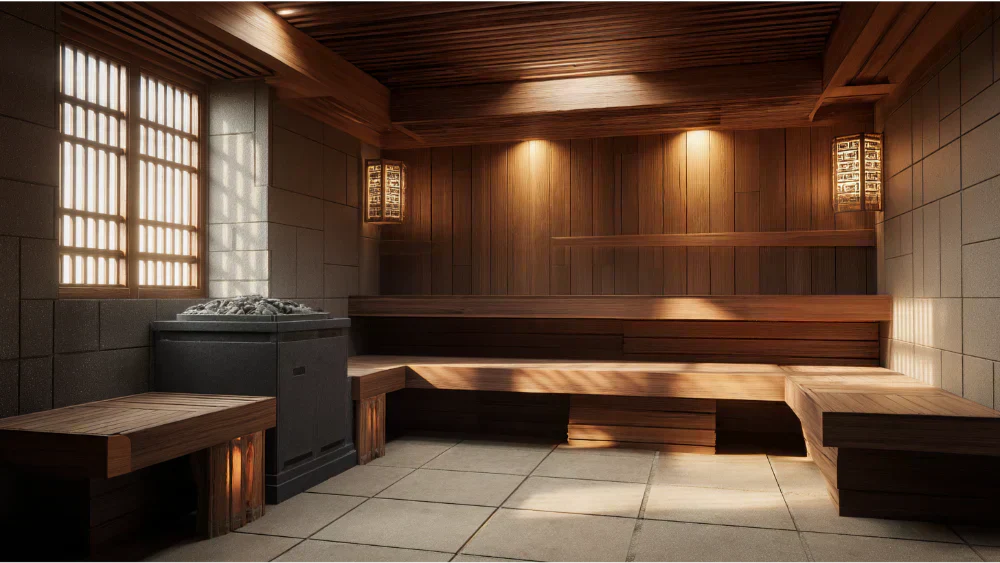Elevated Wellness Begins with the Right Heat
In the ever-evolving world of wellness, the debate around infrared vs. traditional sauna has become increasingly relevant. As busy professionals and high performers seek effective, efficient ways to restore balance and vitality, sauna therapy has emerged as a powerful ritual. But with so many options, how do you know whether an infrared sauna or a traditional sauna is the right investment?
This guide breaks down the key differences between the two, highlighting the health benefits, sensory experiences, and lifestyle considerations that matter most. Whether you're looking for gentle heat, intense heat, or something deeply immersive, you’ll walk away with clarity, and confidence in your choice.
What Is the Difference Between Infrared and Traditional Saunas?

How Traditional Saunas Work
Traditional saunas rely on either electric or wood-burning stoves to generate heat in the surrounding air. Inside a sauna room, large stones are heated to high temperatures. Water is then poured over these hot rocks, producing steam and significantly heating the space. This is what creates the enveloping, immersive experience associated with Finnish style saunas.
Traditional saunas heat the air to higher temperatures, typically between 180°F and 200°F. This environment produces extreme heat and a full-body response, prompting users to induce sweating, boost blood circulation, and experience deep relaxation in short bursts.
How Infrared Saunas Work
By contrast, infrared saunas use infrared heaters or infrared lamps to emit infrared light that penetrates the body directly. Instead of heating the surrounding air, they use infrared heat to raise your core temperature from within. This allows infrared saunas to operate at lower temperatures, typically between 120°F and 150°F, while still delivering heat therapy benefits.
This is why infrared sauna therapy is often referred to as dry heat saunas. There’s no steam or humidity, just warmth delivered through deep penetrating heat.
The Sensory Experience: Ritual vs. Efficiency
Traditional Sauna: Steam, Ritual, and Connection
A traditional sauna is more than a heat chamber. It’s a place for stillness, ceremony, and connection. The act of chopping wood, lighting a fire, and pouring water over rocks brings a grounded, ancestral rhythm to the experience. The steam, called “löyly” in Finnish culture, adds moisture to the hot air, enhancing sweat and intensifying the heat exposure.
The sensory elements, crackling fire, warm wood scent, soft light, make traditional and infrared saunas vastly different experiences. In a traditional setting, it’s about more than sweating. It’s about presence.
Infrared Sauna: Calm, Convenient, and Controlled
An infrared model is ideal for those who value simplicity and consistency. Most infrared saunas operate with minimal setup, can be placed indoors, and allow for longer sauna sessions due to lower temperatures. There’s no steam or hot rocks, making it cleaner and more manageable for some.
The environment is quieter and more meditative. The gentle heat of infrared light feels like sun on the skin, subtle but penetrating.
Health Benefits of Infrared and Traditional Saunas
Cardiovascular Health and Circulation
Both infrared sauna vs traditional sauna methods support the cardiovascular system by increasing blood flow and raising heart rate in a controlled, therapeutic way. However, long-term studies on traditional sauna use show clear, measurable improvements in heart health.
Frequent sauna use, particularly in traditional saunas, is associated with lower blood pressure, improved cardiorespiratory fitness, and a reduced risk of cardiovascular related mortality. In one long-term Finnish study, men who used a sauna 4–7 times per week had significantly lower rates of cardiovascular events, including stroke and heart disease.
Infrared sauna therapy is still being explored in this area, but early research suggests similar improvements in blood circulation and lower blood pressure through regular use.
Detoxification and Sweat Response
Sauna bathing in both formats helps the body induce sweating, which supports enhanced detoxification. As core temperature rises, sweat flushes out toxins through the skin.
Infrared saunas offer the advantage of deep penetrating heat, which some believe may help mobilize toxins stored in fat and tissues. The idea is that infrared heat reaches deeper than traditional external heating, though more clinical studies are needed to fully validate this claim.
Muscle Recovery and Pain Relief
Heat is a natural muscle relaxant. Whether after a workout or a long day, both infrared and traditional saunas support muscle recovery and reduced soreness. Infrared saunas use targeted infrared light to warm the body directly, which may help relieve joint stiffness and support those with chronic conditions like chronic fatigue syndrome.
Traditional saunas, by generating high heat and steam, support overall recovery through increased blood flow, improved oxygenation, and faster waste removal in muscles.
Mental Health and Stress Reduction
One of the most cited health benefits of sauna use is its impact on mental health. The combination of heat, stillness, and mindful breathing reduces cortisol and triggers the parasympathetic nervous system.
Infrared saunas work gently and gradually to calm the body. Traditional saunas, with their intense, sensory-rich environment, can deliver a cathartic release, sweat pouring, heart pounding, clarity emerging. Both are valid, and both offer real support for stress resilience.
Practical Differences: What Fits Your Lifestyle

Session Duration and Temperature Tolerance
Because infrared saunas use lower temperatures, many users can stay inside for infrared sauna sessions lasting 30 to 45 minutes. This extended exposure is often appealing to those who want slow, meditative heat.
With traditional sauna, the higher temperatures usually limit use to 10 to 20 minutes per round. But that intensity delivers potent benefits quickly, making it ideal for those who want various health benefits without carving out a long time window.
Indoor vs Outdoor Sauna Considerations
If you live in a compact home or prefer private wellness rituals, an indoor sauna may appeal to you. Most infrared models are designed for indoor use and require minimal space or construction.
However, if you crave immersion in nature, a traditional outdoor sauna offers unmatched serenity. Products like Kyfe Sauna provide the authentic Finnish style saunas experience, with hot rocks, wood-fired stoves, and portability. You can enjoy your session under stars, beside a lake, or deep in the forest, anywhere you seek stillness.
Portability and Installation
Infrared heaters are easy to install. Most plug into a standard outlet and are ready within minutes. But they’re stationary, and typically not built for rugged conditions.
Kyfe's outdoor sauna flips the narrative. It’s fully portable, fits up to six people, and reaches higher temperatures with real sauna rocks and a wood-burning stove. This means you can create a world-class heat experience in your backyard or on your next wilderness escape.
Energy Efficiency and Cost
In terms of energy efficiency, infrared saunas use less electricity and maintain steady operating costs. But traditional sauna sessions can be short and potent, requiring only occasional wood or electric input for big gains.
Both offer value, and personal preference, not just energy use, should guide the decision.
Infrared vs Traditional Sauna: Which Is Better?

It depends on your priorities. Here’s a side-by-side breakdown:
|
Attribute |
Traditional Sauna |
Infrared Sauna |
|---|---|---|
|
Heating Mechanism |
Heats surrounding air and hot rocks |
Infrared lamps emit heat to the body directly |
|
Temperature |
180–200°F (higher temperatures) |
120–150°F (lower temperatures) |
|
Steam / Löyly |
Yes, adds moisture and intensity |
No, completely dry |
|
Installation |
Requires outdoor setup or ventilation |
Easy indoor installation |
|
Energy Use |
More fuel or electricity |
Energy efficient |
|
Duration |
10–20 min per round |
30–45 min per session |
|
Experience |
Ritualistic, communal, natural |
Quiet, solo, modern |
|
Portability |
Kyfe Sauna: Yes |
Most models: No |
|
Research Backing |
Extensive clinical studies |
Emerging but promising |
|
Emotional Resonance |
Deep connection and grounding |
Subtle and calming |
The Kyfe Perspective: Why We Choose Wood, Rocks, and Ritual
At Kyfe, we don’t follow trends. We follow tradition, excellence, and emotional resonance. Our outdoor sauna isn’t just a product, it’s a philosophy. Fire, stone, steam, and nature combine to create something irreplaceable.
We believe the benefits of traditional saunas go beyond physical. They foster presence, connection, and resilience. With Kyfe Sauna, you get numerous health benefits, heat therapy, and cardiovascular health support in a portable, powerful design.
We use real sauna rocks. We reach over 200°F. We create sauna bathing rituals that reset the mind and body.
Ready to bring tradition anywhere? Explore the Kyfe Sauna experience and discover what happens when heat becomes ceremony.
Frequently Asked Infrared vs. Traditional Sauna Questions
What are the benefits of infrared saunas vs traditional sauna?
Infrared saunas offer longer sessions at lower temperatures, are easier to install, and may support pain relief and detox. Traditional sauna offers intense heat, steam, and stronger evidence for cardiovascular health and reduced risk of heart disease.
Is infrared sauna therapy safe for daily use?
Yes, most people tolerate infrared sauna therapy well on a daily basis, especially due to its gentle heat. Always stay hydrated and monitor how your body responds.
Can traditional and infrared saunas both support heart health?
Yes, both promote blood circulation, support blood pressure regulation, and may contribute to improved cardiovascular health, although traditional sauna has more robust research behind it.
Do infrared saunas work better for pain and inflammation?
Many users report relief from chronic pain and stiffness due to deep penetrating heat. However, sauna therapy in general, infrared or traditional, can support inflammation recovery and muscle recovery.
Are there differences in skin health benefits?
Yes, both can improve skin health through sweating, detox, and circulation. Infrared light may stimulate collagen production, while traditional saunas exfoliate and cleanse pores via steam.
Final Thought: The Choice Is Yours, Make It Meaningful
Whether you choose a traditional sauna for its ritual and intensity, or an infrared sauna for its ease and accessibility, you’re investing in your health and presence.
Sauna use is not a trend. It’s a timeless reset for mind, body, and spirit. And with Kyfe, you’re not just choosing heat. You’re choosing how you want to live.



Best Time to Use Sauna for Weight Loss: The Complete Guide
The Ideal Cold Plunge Temperature: A Refined Guide to Cold Water Immersion for Whole Body Wellness